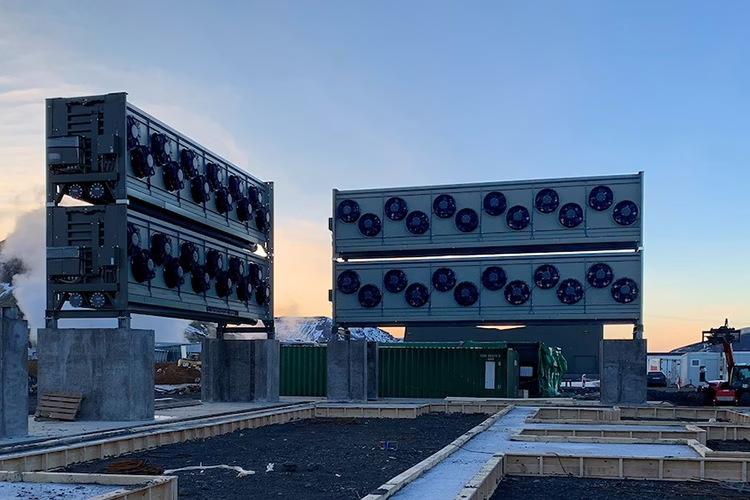In 2015, 195 countries along with the European Union signed the Paris Agreement, committing to plans aimed at limiting the global temperature increase to 1.5 degrees Celsius. However, by 2023, the world had surpassed this target for most, if not all, of the year, raising concerns about the long-term feasibility of achieving this goal.
To address this, the world needs to reduce greenhouse gas levels in the atmosphere, and strategies to reach levels that « stabilize the climate » have been proposed and adopted. Many of these strategies combine dramatic reductions in carbon dioxide (CO2) emissions through the use of direct air capture (DAC), a technology that removes CO2 from the ambient air. To assess the reality, a team of researchers from the MIT Energy Initiative (MITEI) examined these strategies and found alarming results: the strategies rely on overly optimistic, even unrealistic, assumptions about the amount of CO2 that could be removed by DAC. Consequently, the strategies will not work as planned. Nonetheless, the MITEI team recommends that efforts to develop DAC technology continue so that it is ready to contribute to the energy transition, even if it is not the miracle solution that will solve the global decarbonization challenge.
DAC: The Promise and the Reality
Including DAC in climate stabilization plans makes sense. Many efforts are currently underway to develop DAC systems, and the technology appears promising. Even if companies never manage their own DAC system, they can already purchase « carbon credits » based on DAC. There is now a multi-billion-dollar market where entities or individuals facing high costs or excessive disruptions to reduce their own carbon emissions can pay others to take emission reduction actions on their behalf. These actions can involve undertaking new renewable energy projects or « carbon removal » initiatives such as DAC or afforestation/reforestation (planting trees in areas that have never been forested or were in the past).
DAC-based credits are particularly attractive for several reasons, explains Howard Herzog, a senior research engineer at MITEI. With DAC, measuring and verifying the amount of carbon removed is straightforward; the removal is immediate, unlike forest planting, which can take decades to have an impact; and when DAC is coupled with CO2 storage in geological formations, the CO2 is kept out of the atmosphere essentially permanently—unlike, for example, its sequestration in trees, which could one day burn and release the stored CO2.
Will current plans relying on DAC be effective in stabilizing the climate in the coming years? To find out, Herzog and his colleagues Jennifer Morris and Angelo Gurgel, both principal researchers at MITEI, and Sergey Paltsev, a principal researcher at MITEI—all affiliated with the MIT Center for Global Change Science and Policy (CS3)—closely examined the modeling studies on which these plans are based.
Their investigation identified three unavoidable technical challenges that together lead to a fourth challenge: the high costs of removing a single ton of CO2 from the atmosphere. The details of their findings are reported in a paper published in the journal One Earth on September 20.
Challenge 1: Scaling Up
When it comes to removing CO2 from the air, nature presents « a major and non-negotiable challenge, » the MITEI team notes: The concentration of CO2 in the air is extremely low—only 420 parts per million, or about 0.04 percent. In contrast, CO2 concentration in flue gases emitted by power plants and industrial processes ranges from 3 to 20 percent. Companies now use various carbon capture and storage (CCS) technologies to capture CO2 from their flue gases, but capturing CO2 from the air is much more challenging. To explain, the researchers offer the following analogy: « The difference is akin to having to find 10 red marbles in a jar of 25,000 marbles with 24,990 blue ones [the task representing DAC] rather than having to find about 10 red marbles in a jar of 100 marbles with 90 blue ones [the task for CCS]. »
Given this low concentration, removing a single metric ton (ton) of CO2 from the air requires processing about 1.8 million cubic meters of air, roughly equivalent to the volume of 720 Olympic-sized swimming pools. And all that air must be moved through a CO2-capturing sorbent—a feat requiring large equipment. For example, a recently proposed design to capture 1 million tons of CO2 per year would require an « air contactor » the size of a structure about three stories high and three miles long.
Recent modeling studies project the deployment of DAC at a scale of 5 to 40 gigatons of CO2 removed per year. (One gigaton equals 1 billion metric tons.) But in their paper, the researchers conclude that the likelihood of deploying DAC at the gigaton scale is « highly uncertain. »
Challenge 2: Energy Needs
Given the low concentration of CO2 in the air and the need to move large volumes of air to capture it, it is not surprising that even the best DAC processes proposed today consume large amounts of energy—energy typically supplied by a combination of electricity and heat. Including the energy needed to compress the captured CO2 for transport and storage, most proposed processes require the equivalent of at least 1.2 megawatt-hours of electricity for every ton of CO2 removed.
The source of this electricity is crucial. For example, using coal-based electricity to drive an all-electric DAC process would generate 1.2 tons of CO2 for every ton of CO2 captured. The result would be a net increase in emissions, defeating the very purpose of DAC. It is therefore clear that energy needs must be met either by using low-carbon electricity or by using electricity generated from fossil fuels with CCS. All-electric DAC deployed at a large scale—say, 10 gigatons of CO2 removed each year—would require 12,000 terawatt-hours of electricity, which represents more than 40% of today’s total global electricity production.
Electricity consumption is expected to increase due to the growing overall electrification of the global economy, so low-carbon electricity will be in high demand for many competing uses, for example in power generation, transportation, industry, and building operations. Using clean electricity for DAC rather than to reduce CO2 emissions in other critical areas raises concerns about the best uses of clean electricity.
Many studies assume that a DAC unit could also obtain energy from « waste heat » generated by a nearby industrial process or facility. According to MITEI researchers, « this may be more wishful thinking than reality. » The heat source would need to be within a few kilometers of the DAC plant for heat transport to be economical; given its high capital cost, the DAC plant would need to operate continuously, requiring a constant heat supply; and heat at the temperature required by the DAC plant would have competing uses, for example for heating buildings. Finally, if DAC is deployed at the gigaton scale per year, waste heat will likely provide only a small fraction of the required energy.
Challenge 3: Site Selection
Some analysts have claimed that since air is everywhere, DAC units can be located anywhere. But in reality, choosing a site for a DAC plant involves many complex issues. As noted above, DAC plants require significant amounts of low-carbon energy, so access to sufficient low-carbon energy is critical. Similarly, having nearby options for storing the removed CO2 is also critical. If there are no storage sites or pipelines to such sites, major new infrastructure will need to be built, and building new infrastructure of any kind is costly and complicated, involving issues related to permitting, environmental justice, and public acceptability—issues that are, in the researchers’ words, « often underestimated in the real world and overlooked in models. »
Two other site-related needs must be considered. First, weather conditions must be acceptable. By definition, any DAC unit will be exposed to the elements, and factors such as temperature and humidity will affect process performance and availability. Second, a DAC plant will require dedicated land—even though it is not yet clear how much, as the optimal spacing of units is not yet resolved. Like wind turbines, DAC units must be properly spaced to ensure maximum performance, so that one unit does not draw in CO2-depleted air from another unit.
Challenge 4: Cost
Considering the first three challenges, the final challenge is clear: the cost per ton of CO2 removed is inevitably high. Recent modeling studies assume DAC costs as low as $100 to $200 per ton of CO2 removed. But the researchers found evidence suggesting much higher costs.
To start, they cite the typical costs of power plants and industrial sites that now use CCS to remove CO2 from their flue gases. The cost of CCS in such applications is estimated to be between $50 and $150 per ton of CO2 removed. As explained above, the much lower concentration of CO2 in the air will result in significantly higher costs.
As explained in Challenge 1, the DAC units needed to capture the required amount of air are massive. The capital cost of building them will be high, considering labor, materials, permitting costs, etc. Some estimates in the literature exceed $5,000 per ton captured per year.
Then there are the ongoing energy costs. As noted in Challenge 2, removing 1 ton of CO2 requires the equivalent of 1.2 megawatt-hours of electricity. If this electricity costs $0.10 per kilowatt-hour, the cost of the electricity needed to remove 1 ton of CO2 is $120. The researchers point out that assuming such a low price is « questionable, » given the expected increase in electricity demand, future competition for clean energy, and higher costs in a system dominated by renewable—but intermittent—energy sources.
Then there is the cost of storage, which is ignored in many DAC cost estimates.
Clearly, many considerations show that prices of $100 to $200 per ton are not realistic, and assuming such low prices would skew the evaluation of strategies, leading them to underperform in the future.
The Bottom Line
In their paper, the MITEI team describes DAC as a « very seductive concept. » Using DAC to draw CO2 from the air and generate high-quality carbon removal credits can offset reduction requirements for industries with hard-to-reduce emissions. In doing so, DAC would minimize disruptions in key sectors of the global economy, including aviation, certain carbon-intensive industries, and agriculture. However, the world would need to generate billions of tons of CO2 credits at an affordable price. This prospect seems unlikely. The largest DAC plant in operation today removes only 4,000 tons of CO2 per year, and the purchase price of the company’s carbon removal credits on the market today is $1,500 per ton.
The researchers acknowledge that energy efficiency improvements are possible in the future, but DAC units will still be subject to higher work requirements than CCS applied to flue gases from power plants or industrial sources, and there is no clear path to reducing work requirements well below the levels of current DAC technologies.
Nonetheless, the researchers recommend that efforts to develop DAC continue « as they may be needed to achieve net-zero goals, especially given the current pace of emissions. » But their paper concludes with this warning: « Given the high stakes of climate change, it is imprudent to rely on DAC to be the hero that comes to our rescue. »



